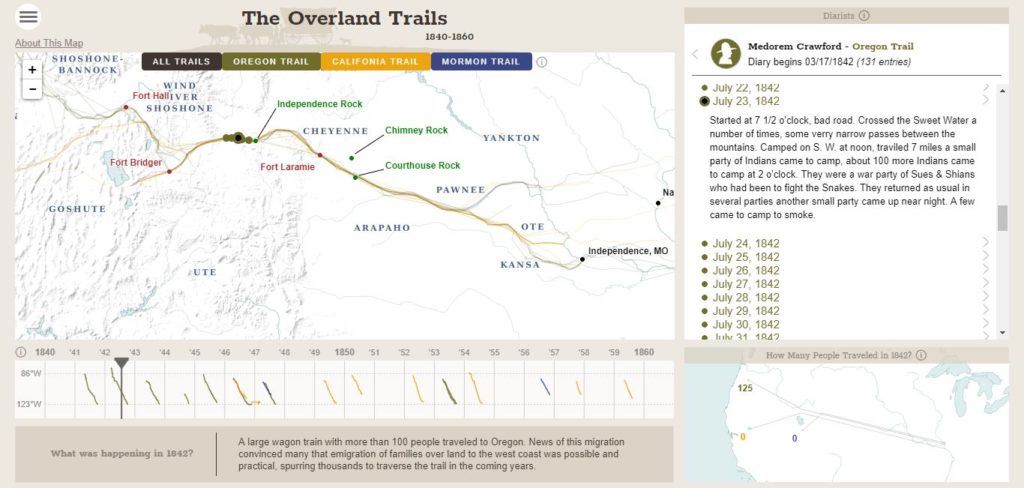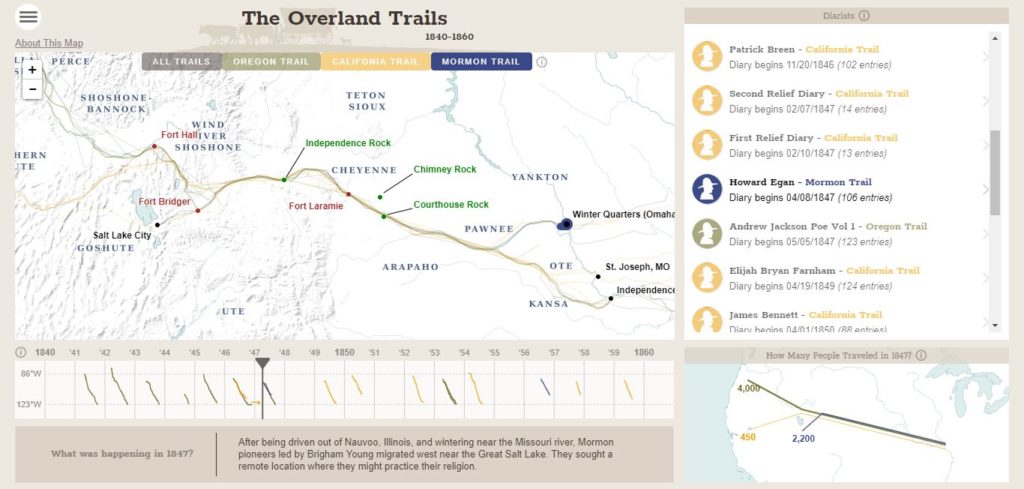Project Review: The Overland Trails
American Panorama: Overland Trails. https://dsl.richmond.edu/panorama/overlandtrails/. Created and maintained by the Digital Scholarship Lab, University of Richmond, https://dsl.richmond.edu/panorama/overlandtrails/#loc=5/-5.200/0.330&date=1/1/1840. Reviewed February 3,2019.
This project highlights both the differences and the similarities between the journeys of various travelers in their journeys on the Overland Trails. Many people chose to pursue a new life in the west between 1840 and 1860, and this project attempts to explain the context surrounding these migrations.
The most notable part of this project is the presentation of entries from 22 difference journals that had been kept by both men and women who journeyed over either the Oregon, California, or Mormon trail. The journals were obtained from multiple sources, and each one varies length and detail. A column on the right lists each journal and its author. Upon clicking on one of the journals, the user can select an entry to read its contents. When an entry is selected, the estimated location at which the entry was written is shown on the map. Part of the team that created this project was dedicated solely to plotting the approximate location of each journal entry with help from historical trail data from the National Park Service. Under the map, there is a chart that depicts the date-ranges of the journal entries. To the right of this, there is a simplified map of the trails with estimates of how many settlers used the trails in each given year. The creators of this project obtained their data for these numbers from John D. Unruh’s The Plain’s Across: The Overland Emigrants and the Trans-Mississippi West, 1840-60, and they remind users that these numbers are only estimates. On the very bottom of the page is a box that provides historical context to each of the years and journal entries. This information comes from various sources.

This project provides a lot of interesting information, but it is presented in a way that requires no previous knowledge of the Overland Trails. I believe it could be useful for any historian who is interested in the diaries of these travelers, whether they be academic scholars or casual learners. It’s very interactive, making it almost fun to explore the information. The project is extremely easy to navigate. Though the paths that each journal draws intersect constantly, the map is far from confusing. The paths of the journals are color-coded based on what trail they follow, and it is possible to filter out different journals by selecting one of the specific trails at the top of the map. Below, you can see that, if “Mormon Trail” is selected, only the Mormon Trail is highlighted on the map, and only journals written by those who traveled on the Mormon Trail are emphasized.

By using the map in conjunction with the journals, this project is able to show the interconnectedness of these different narratives. The threads of these stories come together to weave a much more complete picture of the history of the Overland Trails than reading the diaries on their own could provide.
One Comment
Maeve Kane
Good! What do you think the reader gains by seeing all of these journals presented together, instead of a deep dive into one or more kinds of sources like you would get in a traditional piece?